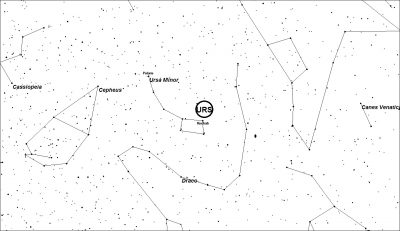 Location of the Ursid (URS) radiant on December 22/23. Star chart courtesy Southern Star Systems
Location of the Ursid (URS) radiant on December 22/23. Star chart courtesy Southern Star SystemsThe Ursid meteor shower is the least observed of the major annual showers. In the northern hemisphere December nights are cold and often cloudy. Another hindrance is the fact that it peaks just before the Christmas holiday when many people are busy with holiday festivities. This shower is completely invisible from the southern hemisphere as the radiant lies too far north to be seen from south of the equator this time of year.
The Ursids are active from December 19-24 with a sharp maximum on December 22nd. Activity is normally low away from maximum with rates less than 1 shower member per hour. On the 22nd though, the earth passes closest to the core orbit of comet 8P/Tuttle. The closest encounter is predicted to occur near 21:39 Universal Time on December 22nd. This timing favors eastern Asia, where the radiant will be highest in a dark sky. The northern polar and sub-polar regions are also favored as the radiant remains high in the sky at all times.
At maximum, the Ursid radiant lies just west of the fairly bright (2nd magnitude) star known as Kochab (beta Ursae Minoris). To those not familiar with star names, this area lies adjacent to the bowl of the “Little Dipper” as shown in the star chart. This area of the sky lies lowest in the northern sky near 20:00 (8pm) local standard time. This is the worst time to view the Ursids as most of the activity will occur beyond your line of sight, below the northern horizon. As the night progresses the Ursid radiant will slowly rise higher into the sky and is best placed during the last dark hour before dawn. To best view this activity it is suggested that you face toward the northern half of the sky. It doesn’t have to be directly at the radiant, but it’s a good idea to have the radiant within your field of view to help with shower association. Don’t look straight up as this is the worst place to look for meteors. Lower you view so that none of the horizon blocks your view. About half way up in the sky is suggested for most observers.
Despite the bitter cold, try to view for at least an hour. Meteor activity is notoriously variable and if you view for only a short time, it may occur during a lull in activity. Viewing for at least an hour ensures you will see several peaks and valleys of activity. Serious observers can contribute to our knowledge of the Ursids by providing data on each meteor they see. The time and magnitude of each meteor are most important. Additional information such as color, velocity, and persistent train phenomena can also be recorded. Note that not every meteor will be an Ursid. There are several minor showers also active during this period adding a few meteors to the hourly total. There are also upwards of 10 random meteors appearing each hour to add to your count. Therefore shower association of each meteor must be included.
Observers are encouraged to share their meteor observations with the International Meteor Organization as soon as possible after the session by filling out an online visual form at: https://www.imo.net/members/imo_observation/add_observation If you happen to be observing at a time of high meteor activity be sure to use smaller time periods within your session so that no period has excess of 20 meteors.
Conditions are favorable for viewing the Ursids as the moon’s phase will be a waning crescent situated in the constellation of Libra. It will rise at approximately 04:00 local standard time and will not interfere with observing as long as you face toward the northern half of the sky. Even of your location lies in daylight at the predicted time of maximum, everyone when clear skies is encouraged to try and view these meteors on the nights of December 21/22 and 22/23 to help add to our knowledge of the source of meteor activity.




 You saw something bright and fast? Like a huge shooting star? Report it: it may be a fireball.
You saw something bright and fast? Like a huge shooting star? Report it: it may be a fireball.  You counted meteors last night? Share your results with us!
You counted meteors last night? Share your results with us!  You took a photo of a meteor or fireball? You have a screenshot of your cam? Share it with us!
You took a photo of a meteor or fireball? You have a screenshot of your cam? Share it with us!  You caught a meteor or fireball on video? Share your video with us!
You caught a meteor or fireball on video? Share your video with us!